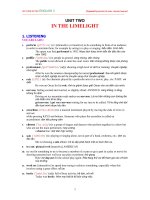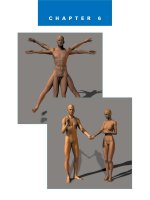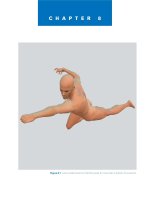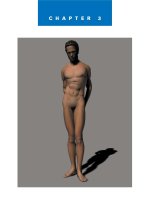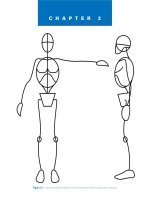Tài liệu Figure Drawing - Lighting the Figure pdf
Bạn đang xem bản rút gọn của tài liệu. Xem và tải ngay bản đầy đủ của tài liệu tại đây (988.65 KB, 24 trang )
CHAPTER 7
Figure 7.1 The lighting shows what kind of material the dress is made of.
Lighting the Figure
✎
133
L
ight is essential to sight. Without light there is no sight, at least not
with our natural eyes. Because figure drawing begins with seeing, a
book about figure drawing should have some significant information
on the nature of light and how our eyes perceive it. Understanding how light
works on objects in a scene helps the artist create a feeling of depth and sub-
stance in a drawing. In Figure 7.1 the lighting on the dress indicates that it is
a dark satin material.
In nature the artist often doesn’t have much control over the lighting of a
scene. About all that can be done to change the lighting is to wait for the sun
to move to a better position. Once the sun is in the right place you had better
draw quickly, though, because it will continue to move, changing the lighting.
In the studio the artist has a lot more control over the lighting of a figure.
In a studio situation the artist can change the lighting of the figure by moving
the light sources or by opening and closing window coverings. Too often the
artist does not take enough time to make sure the lighting of the figure is
exactly right. When using a virtual model, such as in Figure Artist, lighting
becomes even more critical because all lighting in the scene is staged in the
program. Not only does the artist need to understand how to move lights, he
also must understand how to simulate actual lighting effects from real life.
134
Figure Drawing with Virtual Models
Take a look at Figure 7.2. Can
you see any lighting problems?
Would this lighting setup make a
good figure drawing?
In this chapter we will be looking
at how to light a figure. We will
also cover many aspects of shad-
ing your drawings.
Types of Light
There are basically two types of
light in drawing—direct light and
reflected light. Direct light
emanates from a light source, such
as a light bulb or the sun. During a
normal sunny day, the world is
bathed in light with the sun as the
light source. If you were to look
directly at the sun (something your
mother probably told you not to
do), you would be looking at direct
light, as shown in Figure 7.3. The
same thing is true for a light bulb
or a campfire. Anything that cre-
ates light, such as a TV or a com-
puter monitor, is giving off direct
light.
Reflected light bounces off of
objects. We see the world around
us primarily through reflected
light. The yellow, green, and red in
Figure 7.3 are all reflected light.
The light of the sun is bouncing
from the objects and reflecting
back to the viewer.
Figure 7.2 Is this good lighting for a figure drawing?
Figure 7.3 Light that comes directly from a light source is called direct
light.
135
Lighting the Figure
Absorption,
Reflection, and
Pass Through
Light travels in a straight path from
the light source until it hits some-
thing. When light hits an object, it
will do one of three things: It will
bounce off the object, it will be
absorbed by the object, or it will
pass through the object. In Figure
7.4, light is coming from the sun.
When light hits the blue object,
blue light is reflected to the
viewer’s eyes. All non-blue light is
absorbed into the object.
The color of an object is deter-
mined by the light that is absorbed
into it and the light that is reflected
off of it. A white light contains all
colors of visible light. If a white
light strikes a blue object, all colors
other than those that are blue will
be drawn into the object. The blue
light is reflected. What makes the
object blue is that it is reflecting
blue light, as shown in Figure 7.4.
Have you ever noticed that black
clothing is much hotter to wear on
a sunny day than white clothing?
That is because black absorbs all of
the visible light and doesn’t reflect
any light. When light is absorbed
into a surface, it creates heat. On
the other hand, a white shirt
reflects all of the light of the visible
spectrum.
If the object is transparent, some of
the light will pass through the
object. In the case of a transparent
object, such as glass, almost all of
the light will pass through the
object. Figure 7.5 shows light pass-
ing through the blue object. Not
only is blue light reflected, but it is
also the only light that passes
through the blue object, as shown
in Figure 7.5. All of the other light
bands are absorbed into the blue
object.
Figure 7.4 An object is blue because it reflects blue light.
Figure 7.5 Blue light passes through the object.
136
Figure Drawing with Virtual Models
Light and
Shadow
Where there is light there is also
shadow. A shadow is an area of
diminished light because the object
is blocking some of the light from
entering. The light and shadow of
an object help show its shape and
dimensions. In Figure 7.6, the
shadow gives the figure the appear-
ance of standing on the ground,
even though the figure is only seen
in silhouette.
Now let’s take a look at how light
defines a three-dimensional object.
We will start with a simple shape,
such as a sphere. Look at Figure
7.7 and try drawing the picture
of a ball sitting on a tabletop
before you go on to the rest of
the chapter.
Figure 7.6 The shadow helps to plant the figure on the ground.
Figure 7.7 Draw and shade the sphere.
137
Lighting the Figure
Highlight
The highlight of an object is the
part that light directly reflects from
the light source to the viewer’s
eyes. The highlight is located on
the brightest area of the ball, as
shown in Figure 7.8. The highlight
area is at a direct reflection angle
from the light source. If you are
using white paper and a pencil, the
highlight will generally be left as
the white of the paper. For this
reason, you don’t actually draw
the highlight; rather, you draw the
rest of the object and leave the
highlight.
Highlight
Figure 7.8 The highlight is a direct reflection of the light source.
Figure 7.9 Raking light hits a curved surface at an angle.
Raking Light
The area that surrounds the high-
light where the light is not as
directly reflected is called raking
light. The name comes from the
way the light skims across the sur-
face and hits it at an angle. This
area extends outward from the
highlight and gradually gets darker
because the surface of the object is
turning away from the light, as
shown in Figure 7.9.
Raking light
138
Figure Drawing with Virtual Models
Light Area
The area that contains the highlight
and the raking light is the light
area of an object. Most objects can
be defined as having a light area
and a shadow area. Because the
light area receives the most light,
most of the detail in a drawing is in
this area. Figure 7.10 shows the
light area of the ball.
Figure 7.10 The light area of the ball is the area receiving direct light.
Figure 7.11 The shadow area is the area of an object
not receiving direct light.
Shadow Area
Light Area
Shadow Area
All of the area that does not receive
direct light from the light source
is called the shadow area (see
Figure 7.11).
As the surface of the ball turns
away from the light source, it no
longer receives light directly from
the light source. The shadow area
generally receives the least amount
of detail in a drawing because there
is less light to define this area.
139
Lighting the Figure
In situations where there is only
one light shining on an object,
such as a ball, roughly half of the
ball will be in the shadow area and
half will be in the light area.
Viewing the ball directly to the side
of the light source illustrates how
the light and shadow areas are
divided, as shown in Figure 7.12.
Figure 7.12 Half the ball is on the light side, and half
is on the shadow side.
Figure 7.13 The core shadow runs on the line next to
the light side of an object.
Core shadow
Light side
Dark side
Core Shadow
There is a band of shadow that
separates the raking light from the
shadow area of the ball. This
shadow is called the core shadow,
and it is shown in Figure 7.13.
The core shadow runs along the
edge of the object that is directly
past the influence of the light. It is
a very important shadow for the
artist because the core shadow,
more than any other shading,
defines the form. The core shadow
is the darkest shadow on the ball
because it receives the least
amount of light.
140
Figure Drawing with Virtual Models
Reflected Light
The shadow area does not receive
direct light from the light source,
but it does receive indirect light.
Indirect light is reflected from
other surfaces onto the ball. In the
picture of the ball, the light that
hits the table and reflects back to
us also reflects back toward the
ball. The reflected light gives defi-
nition to the shadow area of a
drawing, as shown in Figure 7.14.
Figure 7.15 The cast shadow is the area of shadow
cast from an object onto another surface.
Cast shadow
Figure 7.14 Half the ball is on the light side and half is
on the shadow side.
Reflected light
Cast Shadow
Because the ball interrupts some of
the light traveling from the light
source to the table, there is an area
of shadow on the table. This area
of shadow is called the cast shadow.
It is shown in Figure 7.15.
